
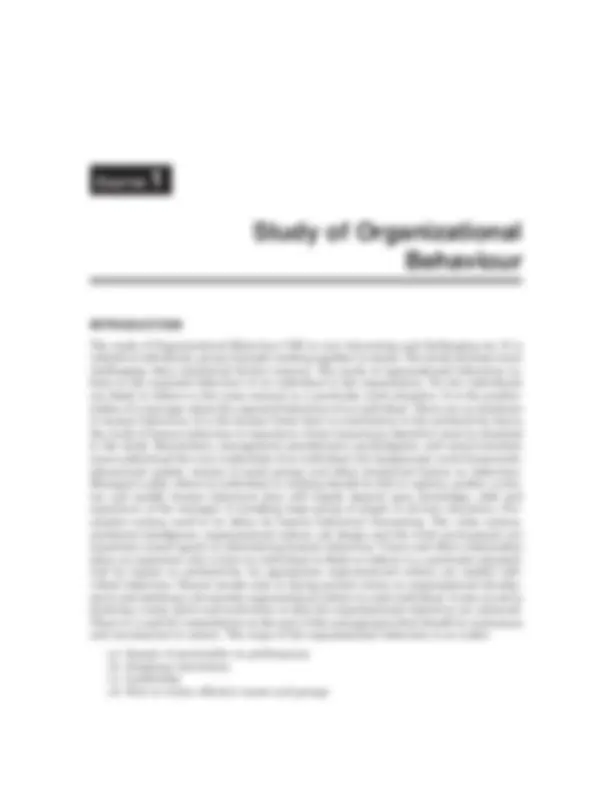
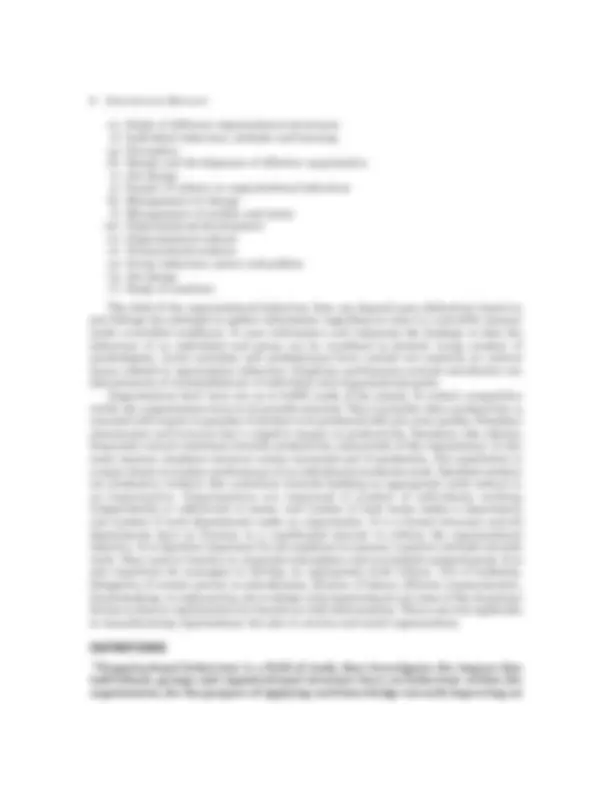
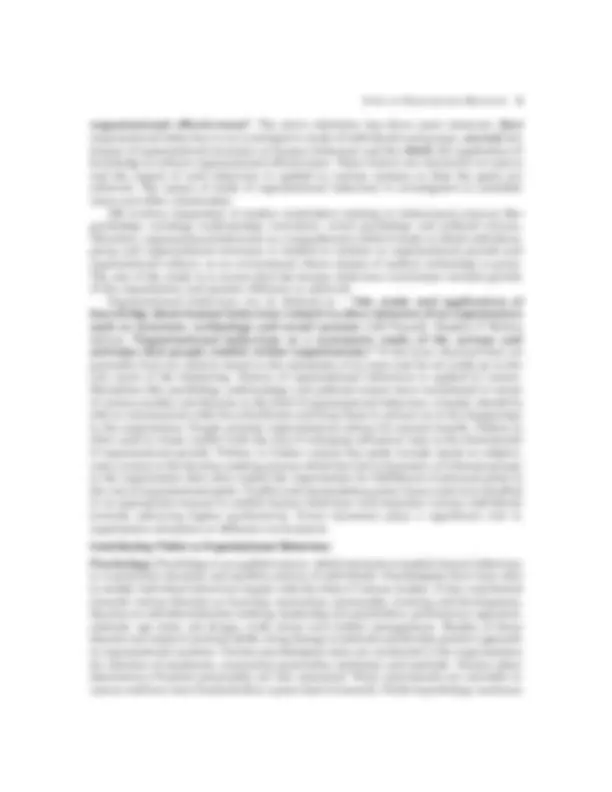
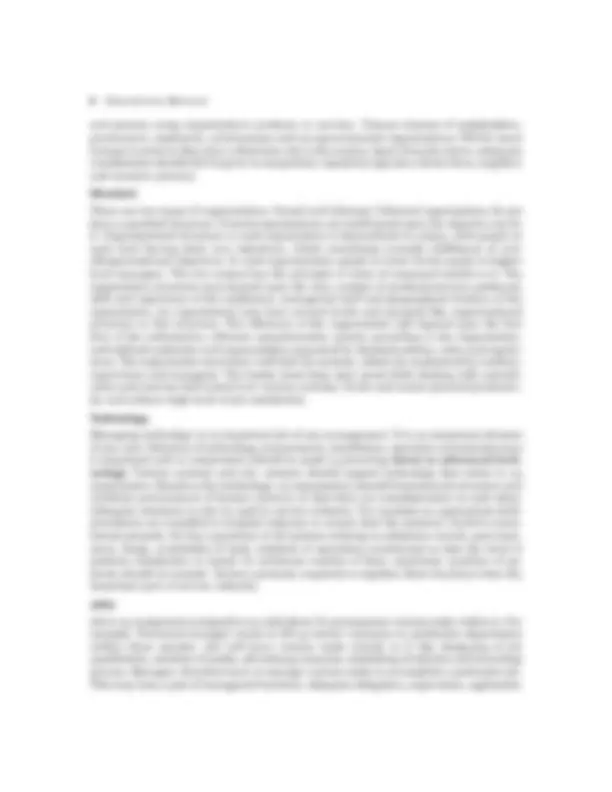
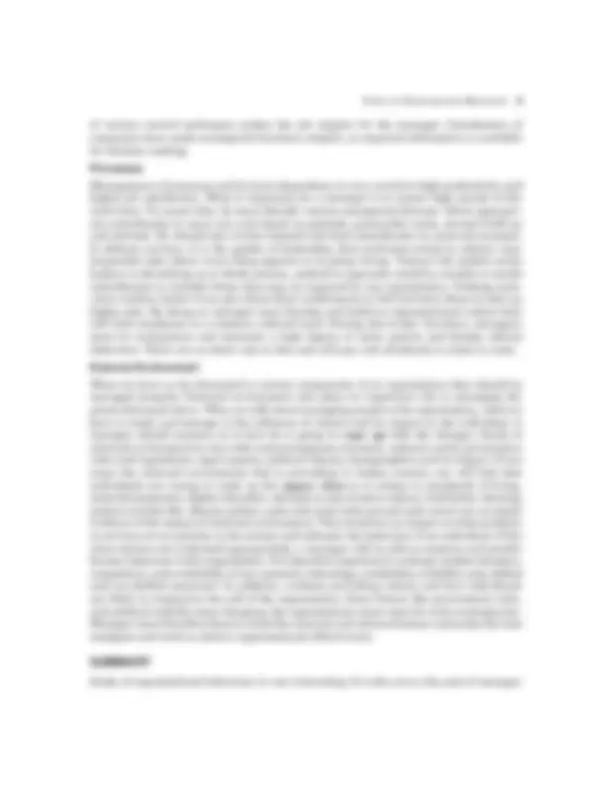
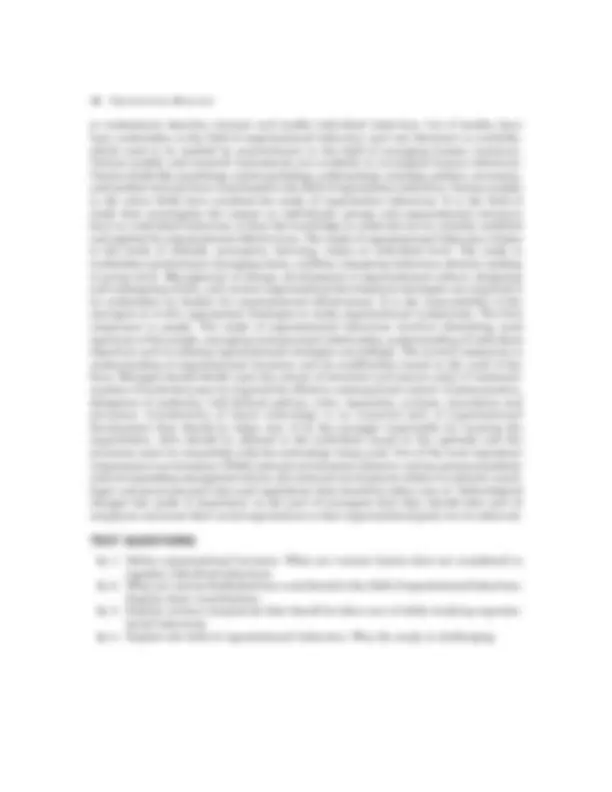
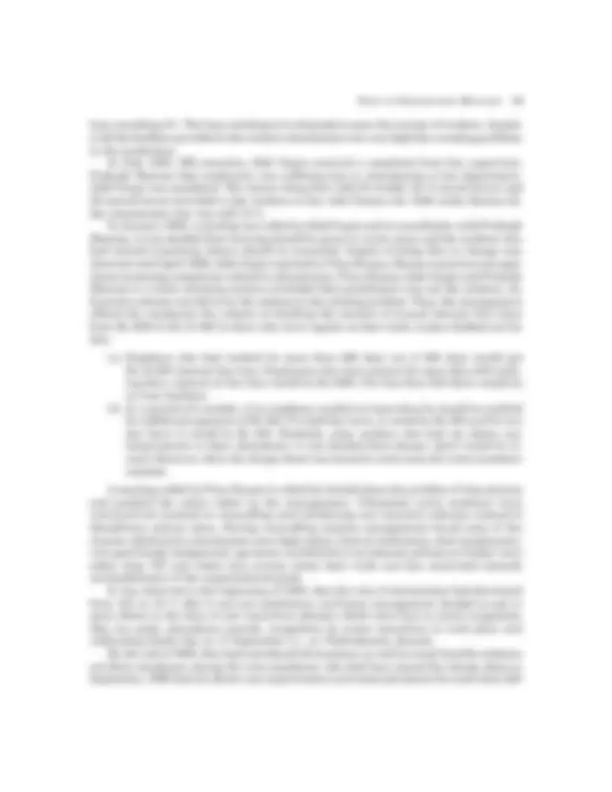
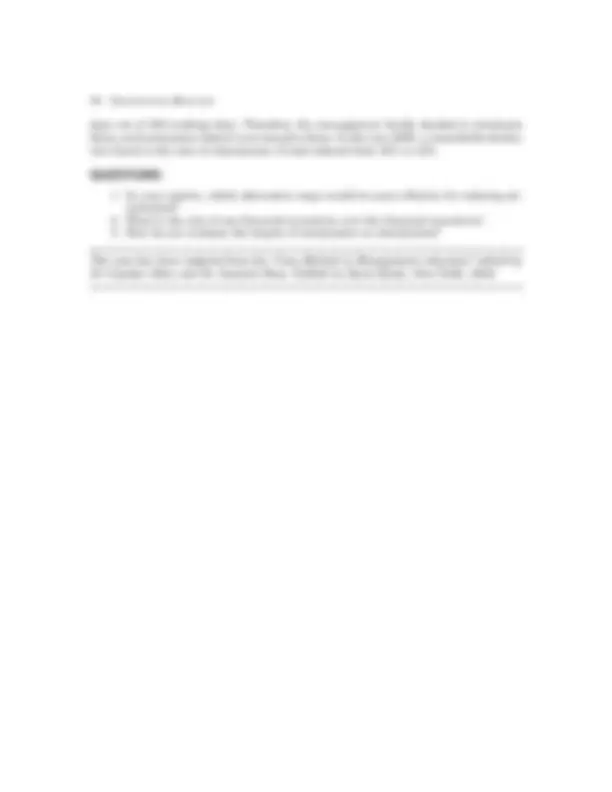


Study with the several resources on Docsity

Earn points by helping other students or get them with a premium plan


Prepare for your exams
Study with the several resources on Docsity

Earn points to download
Earn points by helping other students or get them with a premium plan
Community
Ask the community for help and clear up your study doubts
Discover the best universities in your country according to Docsity users
Free resources
Download our free guides on studying techniques, anxiety management strategies, and thesis advice from Docsity tutors
INTRODUCTION. The study of Organizational Behaviour (OB) is very interesting and challenging too. It is related to individuals, group of people working ...
Typology: Summaries
1 / 14

This page cannot be seen from the preview
Don't miss anything!









4 O RGANIZATIONAL BEHAVIOUR
(e) Study of different organizational structures (f) Individual behaviour, attitude and learning (g) Perception (h) Design and development of effective organization (i) Job design (j) Impact of culture on organizational behaviour (k) Management of change (l) Management of conflict and stress (m) Organizational development (n) Organizational culture (o) Transactional analysis (p) Group behaviour, power and politics (q) Job design (r) Study of emotions The field of the organizational behaviour does not depend upon deductions based on gut feelings but attempts to gather information regarding an issue in a scientific manner under controlled conditions. It uses information and interprets the findings so that the behaviour of an individual and group can be canalized as desired. Large number of psychologists, social scientists and academicians have carried out research on various issues related to organization behaviour. Employee performance and job satisfaction are determinants of accomplishment of individual and organizational goals. Organizations have been set up to fulfill needs of the people. In today’s competitive world, the organizations have to be growth-oriented. This is possible when productivity is ensured with respect to quantity of product to be produced with zero error quality. Employee absenteeism and turnover has a negative impact on productivity. Employee who absents frequently cannot contribute towards productivity and growth of the organization. In the same manner, employee turnover causes increased cost of production. Job satisfaction is a major factor to analyse performance of an individual towards his work. Satisfied workers are productive workers who contribute towards building an appropriate work culture in an organization. Organizations are composed of number of individuals working independently or collectively in teams, and number of such teams makes a department and number of such departments make an organization. It is a formal structure and all departments have to function in a coordinated manner to achieve the organizational objective. It is therefore important for all employees to possess a positive attitude towards work. They need to function in congenial atmosphere and accomplish assigned goals. It is also important for managers to develop an appropriate work culture. Use of authority, delegation of certain powers to subordinates, division of labour, efficient communication, benchmarking, re-engineering, job re-design and empowerment are some of the important factors so that an organization can function as well-oiled machine. This is not only applicable to manufacturing organizations but also to service and social organizations.
“Organizational behaviour is a field of study that investigates the impact that individuals, groups and organizational structure have on behaviour within the organization, for the purpose of applying such knowledge towards improving an
S TUDY OF ORGANISATIONAL BEHAVIOUR 5
organizational effectiveness”. The above definition has three main elements; first organizational behaviour is an investigative study of individuals and groups, second , the impact of organizational structure on human behaviour and the third , the application of knowledge to achieve organizational effectiveness. These factors are interactive in nature and the impact of such behaviour is applied to various systems so that the goals are achieved. The nature of study of organizational behaviour is investigative to establish cause and effect relationship. OB involves integration of studies undertaken relating to behavioural sciences like psychology, sociology, anthropology, economics, social psychology and political science. Therefore, organizational behaviour is a comprehensive field of study in which individual, group and organizational structure is studied in relation to organizational growth and organizational culture, in an environment where impact of modern technology is great. The aim of the study is to ensure that the human behaviour contributes towards growth of the organization and greater efficiency is achieved. Organizational behaviour can be defined as – “the study and application of knowledge about human behaviour related to other elements of an organization such as structure, technology and social systems (LM Prasad ). Stephen P Robins defines “Organizational behaviour as a systematic study of the actions and attitudes that people exhibit within organizations.” It has been observed that we generally form our opinion based on the symptoms of an issue and do not really go to the root cause of the happening. Science of organizational behaviour is applied in nature. Disciplines like psychology, anthropology and political science have contributed in terms of various studies and theories to the field of organizational behaviour. A leader should be able to communicate with his subordinate and keep them in picture as to the happenings in the organization. People promote organizational culture for mutual benefit. Politics is often used to create conflict with the aim of enlarging self-power base to the detrimental of organizational growth. Politics, in Indian context has made inroads based on religion, caste system in the decision making process which has led to formation of informal groups in the organization that often exploit the organization for fulfillment of personal goals at the cost of organizational goals. Conflict and manipulating power bases need to be handled in an appropriate manner to modify human behaviour and stimulate various individuals towards achieving higher productivity. Power dynamics plays a significant role in organization situations in different environment.
Contributing Fields to Organizational Behaviour
Psychology: Psychology is an applied science, which attempts to explain human behaviour in a particular situation and predicts actions of individuals. Psychologists have been able to modify individual behaviour largely with the help of various studies. It has contributed towards various theories on learning, motivation, personality, training and development, theories on individual decision making, leadership, job satisfaction, performance appraisal, attitude, ego state, job design, work stress and conflict management. Studies of these theories can improve personal skills, bring change in attitude and develop positive approach to organizational systems. Various psychological tests are conducted in the organizations for selection of employees, measuring personality attributes and aptitude. Various other dimensions of human personality are also measured. These instruments are scientific in nature and have been finalized after a great deal of research. Field of psychology continues
S TUDY OF ORGANISATIONAL BEHAVIOUR 7
thus individual behaviour modified. An organization has three basic elements namely, people, structure, and technology. An organization must have suitable organizational structure, with appropriate number of tier and reporting system properly explained. Principle of unity of command, delegation of authority and responsibility, formulation of objectives and its allotment to various groups is very important so that workers achieve a required level of job satisfaction. They must be trained to handle sophisticated machines and equipment. It is the people, their value system, and faith in the leadership that make an organization. Leader must be able to describe, understand, predict and control individual behaviour in the organization. This is explained in the succeeding paragraphs.
(a) Describe: Study of organizational behaviour is based on scientific methods, which have been applied on human beings. It is a science, that analyses as to how people behave in different situations in the organization. A manager should be able de- scribe the behaviour of each of the individuals under his command, identify atti- tude, and be able to pinpoint his behaviour so that the situation in the organization is under control. (b) Understand: Leaders must understand human behaviour as to why people be- have in particular manner and try to identify reasons so that corrective actions can be taken. (c) Predict: By frequent closer interaction, a leader is in a position to identify the nature of workers. Some are more productive while the others are tardy and disruptive. In such situation, a leader should be able to handle each individual differently so that his or her actions can be channalized to higher productivity. (d) Control: Managers in the organizations should train their subordinates continu- ously; aim being development of skills, promotion of productivity and improvement of individual behaviour. It is a continuous process on the part of manager. He must lay down control measures so that the energy of workers is diverted towards orga- nizational objectives. Communication should be used to ensure that the behaviour of individual is controlled. Environment has a great impact on human behaviour. Appropriate internal environment would help organizations to built favourable work environment that will help individuals and groups within organizations to work effectively towards higher productivity.
Organizational Components that Need to be Managed
People
People are the main component of any organization that has to be managed. Every individual has a personal goal to be achieved. Organizations must identify the need spectrum of individuals and take suitable steps for its fulfillment to enable them to perform effectively so that they complete their allotted task in time. Relationship between the workers, with subordinates and superiors should be established based on full understanding and complete faith based on mutual trust so that it is easy to communicate and understand each other’s views. Work teams and Groups play a vital role in the organization. Individual may have to keep his personal interest aside if it conflicts with team or group goals. It is the team goals, accomplishment of which contribute towards achieving organizational goals. Apart from managing internal workforce, it is also important to manage customers who are the
8 O RGANIZATIONAL BEHAVIOUR
end persons using organization’s products or services. Utmost interest of stakeholders, government, employees, social groups and non-governmental organizations (NGOs) must be kept in mind as they play a dominant role in the society. Apart from the above, adequate consideration should also be given to competitors, regulatory agencies, labour force, suppliers and resource persons.
Structure
There are two types of organizations, formal and informal. Informal organizations do not have a specified structure. Formal organizations are build based upon the objective set for it. Organizational structure in such organization is hierarchical in nature, with people at each level having their own objectives, which contributes towards fulfillment of over allorganizational objectives. In such organisastion people at lower levels report to higher level managers. The tier system has the principle of unity of command inbuilt in it. The organization structure may depend upon the size, number of products/services produced, skill and experience of the employees, managerial staff and geographical location of the organization. An organization may have several levels and pyramid like organizational structure or flat structure. The efficiency of the organization will depend upon the free flow of the information, efficient communication system prevailing in the organization, well-defined authority and responsibility supported by detailed policies, rules and regula- tions. The organization must have well laid out systems, which are understood by workers, supervisors and managers. The leader must keep open mind while dealing with subordi- nates and exercise full control over various systems, levels and ensure planned productiv- ity and achieve high level of job satisfaction.
Technology
Managing technology is an important job of any management. It is an important element of any unit. Selection of technology, procurement, installation, operation and maintenance is important and no compromise should be made in procuring latest or advanced tech- nology. Various systems and sub- systems should support technology that exists in an organization. Based on the technology, an organization should formulate job structure and resultant procurement of human resource so that they are complimentary to each other. Adequate attention is also be paid to service industry. For example an appropriate drill, procedures are installed in hospital industry to ensure that the patients’ record is main- tained properly. On line operations of all systems relating to admission record, past treat- ment, drugs, availability of beds, schedule of operations maintained so that the level of patients satisfaction is raised. In minimum number of days, maximum numbers of pa- tients should be treated. Various processes required to regulate these functions form the important part of service industry.
Jobs
Job is an assignment assigned to an individual. It encompasses various tasks within it. For example, Personnel manager wants to fill up twelve vacancies in production department within three months. Job will have various tasks inbuilt in it like designing of job specification, selection of media, advertising vacancies, scheduling of selection and recruiting process. Manager, therefore have to manage various tasks to accomplish a particular job. This may form a part of managerial functions. Adequate delegation, supervision, application
10 ORGANIZATIONAL BEHAVIOUR
to understand, describe, forecast and modify individual behaviour. Lot of studies have been undertaken in the field of organizational behaviour and vast literature is available, which need to be studied by practictioners in the field of managing human resources. Various models and research instruments are available to investigate human behaviour. Various fields like psychology, social psychology, anthropology, sociology, politics, economics, and medical sciences have contributed to the field of organization behaviour. Various models in the above fields have enriched the study of organization behaviour. It is the field of study that investigates the impact on individuals, groups and organizational structure have on individual behaviour so that the knowledge so achieved can be suitably modified and applied for organizational effectiveness. The study of organizational behaviour relates to the study of attitude, perception, learning, values at individual level. The study is undertaken pertaining to managing stress, conflicts, intergroup behaviour, decision making at group level. Management of change, development of organizational culture, designing and redesigning of jobs, and various organizational development strategies are required to be undertaken by leaders for organizational effectiveness. It is the responsibility of the managers to evolve appropriate strategies to study organizational components. The first component is people. The study of organizational behaviour involves identifying need spectrum of the people, managing interpersonal relationship, understanding of individual objectives and co-relating organizational strategies accordingly. The second component is understanding of organizational structure and its modification based on the need of the hour. Manager should decide upon the nature of structure and ensure unity of command, number of levels that may be required for effective command and control. Communication, delegation of authority, well defined policies, rules, regulation, systems, procedures and processes. Introduction of latest technology is an essential part of organizational development that should be taken care of by the manager responsible for running the organization. Jobs should be allotted to the individual based on the aptitude and the processes must be compatible with the technology being used. One of the most important components is environment. While internal environment relates to various personnel policies and corresponding managerial actions, the external environment relates to cultural, social, legal, and governmental rules and regulations that should be taken care of. Technological changes has made it imperative on the part of managers that they should take care of employees and meet their social expectations so that organizational goals can be achieved.
Q. 1. Define organizational bevaiour. What are various factors that are considered to regulate individual behaviour. Q. 2. What are various fields that have contributed to the field of organizational behaviour. Explain their contributions. Q. 3. Explain various components that should be taken care of while studying organiza- tional behaviour. Q. 4. Explain the field of organizational behaviour. Why the study is challenging.
S TUDY OF ORGANISATIONAL BEHAVIOUR 11
V.G. Kondalkar
National Cadet Corps (NCC) is a national organization having junior wing and senior wing both for girls and boys. Junior wing NCC is meant for secondary school level and senior wing is applicable for college students. The objective of NCC organization is to inculcate discipline for the youth of our nation. An Army Officer of the rank of Lt General called Director General (DG) heads NCC organization at national level. The organization has a vast network at each state level headed by an officer of the rank of Brigadier known as Deputy Director General (DDG) of a particular state. In every state there are number of Group Headquarters located at important cities depending upon school and college den- sity and compositions. Under Group Headquarters there are number of NCC Battalions (Boys/ Girls). Number of battalions in each Group Headquarters varies depending upon the size of the area. In the same fashion, number of groups under a DDG varies. NCC is applicable to all school/ college going children. It is voluntary organization in nature. DDGs, group commanders and battalion commanders organize various events round the year. These are as under:
(a) Participation in professional training that includes the following:
S TUDY OF ORGANISATIONAL BEHAVIOUR 13
loan exceeding 4%. The loan entitlement is dependent upon the income of workers. Inspite of all the facilities provided to the workers absenteeism was very high thus creating problems in the production. In July 1995, HR executive, Alok Gupta received a complaint from line supervisor, Prakash Sharma that production was suffering due to absenteeism in his department. Alok Gupta was perplexed. The reason being that with 52 weekly off, 9 casual leaves and 22 earned leaves provided to the workers in line with Factory Act 1948 under Section 52, the absenteeism rate was still 18 %. In January 1996, a meeting was called by Alok Gupta and in consultation with Prakash Sharma, it was decided that warning should be given to cronic cases and the workers who had started remaining absent should be counseled. Inspite of doing this no change was observed until April 1996. Alok Gupta reported to Priya Kumar, Human resources manager about increasing complaints related to absenteeism. Priya Kumar, Alok Gupta and Prakash Sharma in a brain storming session concluded that punishment was not the solution. An Incentive scheme was felt to be the solution to the existing problem. Thus, the management offered the employees the scheme of doubling the amount of annual interest free loans from Rs 5000 to Rs 10 000 to those who were regular at their work. A plan chalked out for this:
(a) Employee who had worked for more than 280 days out of 365 days would get Rs 10,000 interest free loan. Employees who were present for more than 230 work- ing days, amount of free loan would be Rs 5000. For less than 230 there would be no loan facilities. (b) In a period of 4 months, if an employee availed no leave then he would be entitled for additional payment of Rs 500. If a half-day leave, it would be Rs 350 and for one day leave it would be Rs 250. Similarly, some workers who had not shown any improvement in their attendance, it was decided that charge- sheet would be is- sued. However, when the charge sheet was issued to such cases the union members resisted. A meeting called by Priya Kumar in which he briefed about the problem of absenteeism and justified the action taken by the management. Ultimately union members were convinced but insisted on counselling and introducing new incentive schemes instead of disciplinary actions alone. During counselling sessions management found some of the reasons which led to absenteeism were high salary, festival celebration, dual employment, very good family background, age factor and defective recruitment policies as fresher were taken from ITI and where less serious about their work and less motivated towards accomplishment of the organizational goals. It was observed in the beginning of 1999, that the rate of absenteeism had decreased from 18% to 16 %. But it was not satisfactory and hence management decided to put in more efforts in the form of new incentives schemes which were best on social recognition like; tea party, attendance awards, recognition by senior executives at work place and celebrating family day on 17 September i.e., on Vishwakarma Jayanti. By the end of 1999, they had introduced all monetary as well as social benefits schemes yet three employees among the nine employees who had been issued the charge sheet in September, 1998 had not shown any improvement and remained absent for more than 200
14 ORGANIZATIONAL BEHAVIOUR
days out of 280 working days. Therefore, the management finally decided to terminate them, and termination letters were issued to them. In the year 2000, a remarkable decline was found in the rate of absenteeism. It had reduced from 16% to 12%.
The case has been adapted from the “Case Method in Management education” edited by Dr Upinder Dhar and Dr. Santosh Dhar. Publish by Excel Books, New Delhi, 2002.